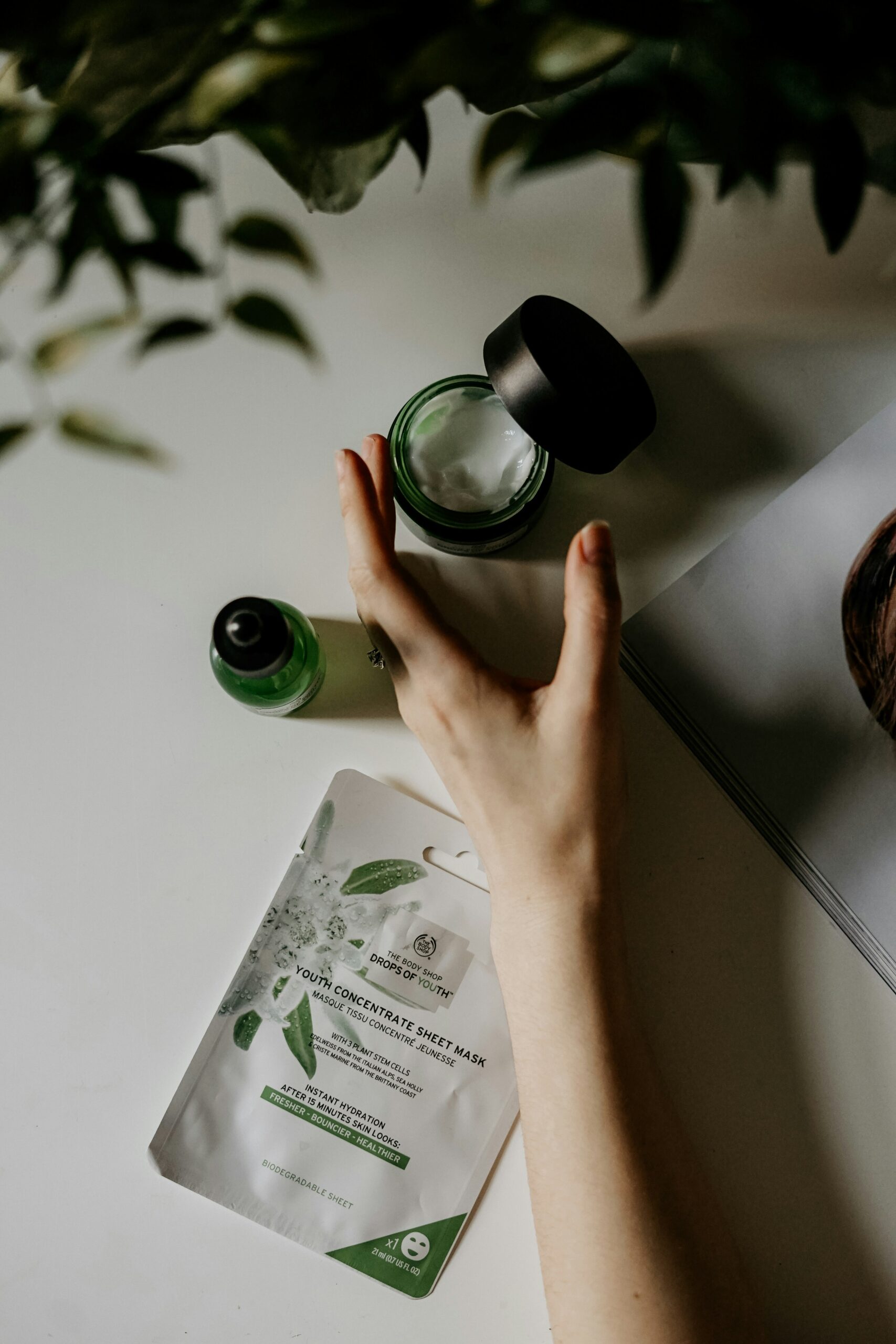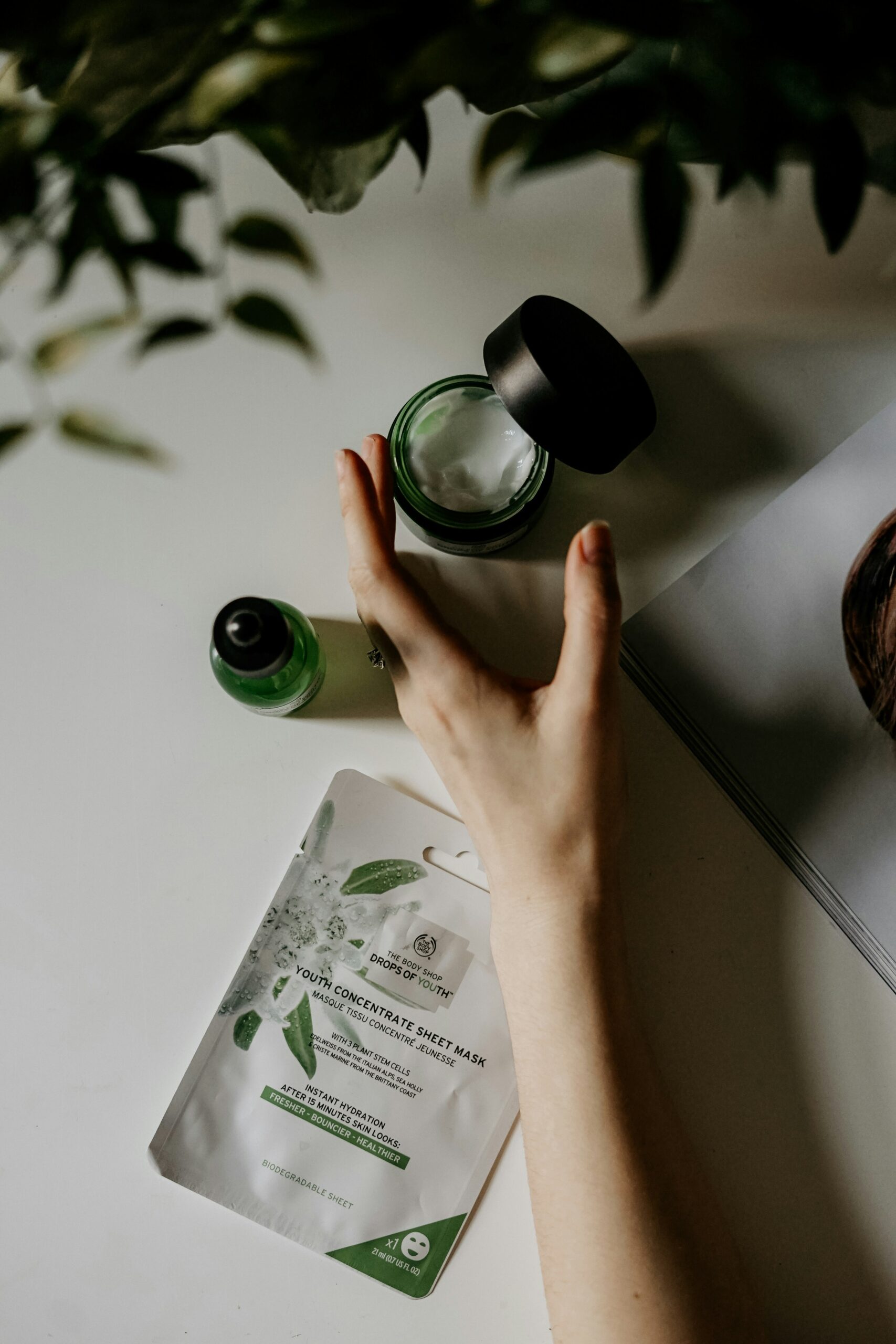Introduction
Glass skin has become a popular beauty trend in recent years. It refers to a complexion that is smooth, clear, and glowing, resembling the appearance of glass. Achieving glass skin requires a consistent skincare routine and certain lifestyle habits. In this blog post, we will discuss the steps you can take to achieve glass skin and maintain a healthy complexion.
To achieve glass skin, it is essential to start with a solid skincare routine. This routine should include cleansing, exfoliating, toning, moisturizing, and protecting the skin. Cleansing is the first step and should be done twice a day, in the morning and at night, to remove dirt, oil, and impurities from the skin. It is important to choose a gentle cleanser that does not strip the skin of its natural oils.
Exfoliating is the next step in achieving glass skin. This process helps to remove dead skin cells, allowing new, fresh skin to surface. There are various exfoliating products available, including physical scrubs and chemical exfoliants. It is important to choose a product that suits your skin type and does not cause irritation.
Toning is an important step in the glass skin routine as it helps to balance the skin’s pH levels and remove any remaining impurities. Toners also help to tighten the pores, giving the skin a smoother appearance. Look for toners that are alcohol-free and contain ingredients like hyaluronic acid or rosewater, which are known for their hydrating and soothing properties.
Moisturizing is a crucial step in achieving glass skin as it helps to hydrate and nourish the skin. Look for a moisturizer that is lightweight, non-comedogenic, and suits your skin type. Ingredients like hyaluronic acid, ceramides, and glycerin are beneficial for maintaining hydration and promoting a healthy complexion.
Protecting the skin from harmful UV rays is also essential in achieving glass skin. Sunscreen should be applied daily, even on cloudy days, to protect the skin from premature aging, sunburn, and skin cancer. Look for a broad-spectrum sunscreen with an SPF of at least 30 and apply it generously to all exposed areas of the skin.
In addition to a consistent skincare routine, certain lifestyle habits can also contribute to achieving glass skin. Drinking plenty of water helps to hydrate the skin from within and flush out toxins. Eating a balanced diet rich in fruits, vegetables, and healthy fats provides the skin with essential nutrients for a healthy complexion.
Getting enough sleep is also crucial for maintaining a healthy complexion. During sleep, the body repairs and rejuvenates the skin, allowing it to look fresh and glowing. Aim for 7-9 hours of quality sleep each night to give your skin the rest it needs.
In conclusion, achieving glass skin requires a consistent skincare routine and certain lifestyle habits. By following the steps outlined in this blog post, you can achieve a smooth, clear, and glowing complexion that resembles the appearance of glass. Remember to be patient and consistent with your skincare routine, as results may take time to show. With dedication and proper care, you can achieve the glass skin of your dreams.
1. Cleanse and Exfoliate
The first step towards achieving glass skin is to cleanse your face thoroughly. Use a gentle cleanser that suits your skin type to remove dirt, impurities, and excess oil. Cleansing helps to unclog pores and prevent breakouts.
Exfoliation is also crucial for achieving glass skin. It helps to remove dead skin cells and promote cell turnover, revealing a fresh and radiant complexion. Use a gentle exfoliator or a chemical exfoliant, such as AHAs or BHAs, to achieve a smooth and even skin texture.
When it comes to cleansing, it’s important to choose a cleanser that is specifically formulated for your skin type. If you have oily skin, opt for a foaming cleanser that can effectively remove excess oil without stripping the skin of its natural moisture. Those with dry or sensitive skin should look for a hydrating cleanser that can nourish and soothe the skin.
실시간 뉴스In addition to cleansing, exfoliation is an essential step in any skincare routine. By removing the buildup of dead skin cells, exfoliation can help to improve the absorption of skincare products and allow them to penetrate deeper into the skin. This can enhance the effectiveness of your skincare routine and help you achieve that coveted glass skin.
There are two types of exfoliation: physical and chemical. Physical exfoliation involves using a scrub or brush to physically remove dead skin cells from the surface of the skin. This can be done with a gentle facial scrub or a soft-bristled brush. Chemical exfoliation, on the other hand, involves using acids or enzymes to dissolve the bonds between dead skin cells, allowing them to be easily sloughed off. AHAs, such as glycolic acid and lactic acid, are effective chemical exfoliants that can help to improve skin texture and tone.
It’s important to note that exfoliation should be done in moderation. Over-exfoliating can disrupt the skin’s natural barrier and lead to irritation, dryness, and sensitivity. It’s best to start with a gentle exfoliant and gradually increase the frequency and intensity as your skin becomes accustomed to it. It’s also important to follow up with a moisturizer to replenish the skin’s moisture barrier and prevent dryness.
2. Hydrate and Moisturize
Hydration is key to achieving glass skin. Drink plenty of water throughout the day to keep your skin hydrated from within. Additionally, use a hydrating toner or essence to provide an extra layer of moisture to your skin.
Moisturizing is essential for maintaining a healthy and plump complexion. Choose a moisturizer that suits your skin type and apply it daily. Look for ingredients like hyaluronic acid, ceramides, and glycerin, which help to lock in moisture and keep your skin hydrated throughout the day.
Aside from drinking water and using hydrating products, there are other ways to ensure that your skin stays hydrated. For instance, incorporating foods that are high in water content into your diet can also contribute to keeping your skin moisturized. Fruits and vegetables such as watermelon, cucumber, and celery are excellent choices as they contain a significant amount of water.
In addition to hydrating your skin, it is important to protect it from external factors that can cause dryness. This includes avoiding prolonged exposure to the sun without protection, as UV rays can damage the skin’s moisture barrier. Make sure to apply a broad-spectrum sunscreen with at least SPF 30 every day, even on cloudy days.
Furthermore, using a humidifier in your home or office can help to add moisture to the air, preventing your skin from becoming dry and dehydrated. This is especially beneficial during the winter months when the air tends to be drier.
Remember, hydrating and moisturizing your skin is an ongoing process. It is important to establish a skincare routine that includes these steps and stick to it consistently. By doing so, you will be able to achieve and maintain the coveted glass skin look.
3. Use a Serum
A serum is a concentrated skincare product that targets specific skin concerns. To achieve glass skin, incorporate a serum into your skincare routine. Look for serums that contain ingredients like vitamin C, niacinamide, or hyaluronic acid. These ingredients help to brighten the skin, reduce hyperpigmentation, and improve overall skin texture.
Serums are an essential step in any glass skin routine because they deliver potent ingredients directly into the skin. They have a lightweight consistency that allows them to penetrate deep into the skin layers, providing maximum benefits. Vitamin C, a popular ingredient in serums, is a powerful antioxidant that brightens the skin and fades dark spots. It also stimulates collagen production, which helps to improve skin elasticity and reduce the appearance of fine lines and wrinkles.
Niacinamide is another key ingredient to look for in a serum. It is a form of vitamin B3 that has multiple benefits for the skin. Niacinamide helps to regulate oil production, making it ideal for those with oily or acne-prone skin. It also reduces inflammation, minimizes pore size, and improves skin texture. With regular use, niacinamide can give your skin a smooth and even-toned appearance.
Hyaluronic acid is a hydrating powerhouse that can work wonders for dry and dehydrated skin. It has the ability to hold up to 1000 times its weight in water, making it incredibly effective at plumping and moisturizing the skin. By incorporating a hyaluronic acid serum into your glass skin routine, you can ensure that your skin stays hydrated and supple throughout the day.
When using a serum, it is important to apply it correctly for optimal results. Start by cleansing and toning your skin, then apply a few drops of serum onto your fingertips. Gently pat the serum onto your face, focusing on areas that need extra attention. Allow the serum to fully absorb before moving on to the next step in your skincare routine.
In addition to using a serum, it is crucial to maintain a consistent skincare routine and practice good overall skin health habits. This includes drinking plenty of water, getting enough sleep, and protecting your skin from the sun’s harmful UV rays. By following these steps and incorporating a serum into your routine, you can achieve the coveted glass skin look and enjoy a radiant and glowing complexion.
4. Protect Your Skin from the Sun
Protecting your skin from the harmful UV rays of the sun is crucial for maintaining a healthy complexion. Excessive sun exposure can lead to premature aging, dark spots, and other skin damage. Always apply a broad-spectrum sunscreen with an SPF of 30 or higher before stepping out in the sun. Reapply every two hours, especially if you are spending extended periods outdoors.
In addition to sunscreen, there are other measures you can take to protect your skin from the sun. Wearing protective clothing such as wide-brimmed hats, long-sleeved shirts, and sunglasses can provide an extra layer of defense against the sun’s rays. Seek shade whenever possible, especially during the peak hours of 10 a.m. to 4 p.m., when the sun’s rays are the strongest.
It’s also important to remember that sunscreen alone is not enough to fully protect your skin. While it is an essential part of your sun protection routine, it should be used in conjunction with other sun safety practices. For example, using an umbrella or a sunshade at the beach or pool can provide additional protection from the sun.
Furthermore, it’s important to be aware of the different types of sunscreens available and choose one that suits your skin type and needs. There are two main types of sunscreens: chemical and physical. Chemical sunscreens work by absorbing the sun’s rays, while physical sunscreens create a protective barrier on the skin’s surface. Both types can be effective, but some people may have sensitivities or preferences for one over the other.
When choosing a sunscreen, look for one that provides broad-spectrum protection, meaning it protects against both UVA and UVB rays. UVA rays are responsible for premature aging and can penetrate through clouds and glass, while UVB rays are the main cause of sunburn. By using a broad-spectrum sunscreen, you can ensure that your skin is protected from both types of rays.
It’s also important to note that sunscreen should be applied generously and evenly to all exposed areas of the skin. Many people make the mistake of not using enough sunscreen or missing certain areas, such as the ears, back of the neck, and tops of the feet. To ensure proper coverage, apply sunscreen at least 15 minutes before sun exposure, allowing it to fully absorb into the skin.
In conclusion, protecting your skin from the sun is essential for maintaining a healthy complexion and preventing skin damage. By using sunscreen, wearing protective clothing, seeking shade, and being mindful of sun safety practices, you can enjoy the outdoors while keeping your skin safe from harmful UV rays.
In addition to consuming a balanced diet, it is also important to stay hydrated to achieve glass skin. Drinking an adequate amount of water helps to flush out toxins from your body and keeps your skin hydrated and plump. Aim to drink at least eight glasses of water per day, and consider incorporating hydrating foods into your diet, such as watermelon, cucumbers, and oranges.
Furthermore, incorporating healthy fats into your diet can also contribute to achieving glass skin. Foods rich in omega-3 fatty acids, such as salmon, avocados, and flaxseeds, help to nourish your skin from within and maintain its elasticity. These healthy fats also aid in reducing inflammation and improving the overall appearance of your skin.
When it comes to achieving glass skin, it is important to avoid certain foods that can negatively impact your skin’s health. Limit your intake of processed foods, as they often contain high amounts of sodium and unhealthy fats that can lead to skin issues such as acne and dullness. Additionally, try to minimize your consumption of sugary beverages and alcohol, as they can dehydrate your skin and contribute to premature aging.
Lastly, consider incorporating skin-boosting supplements into your daily routine. Supplements like collagen, vitamin C, and biotin can help to improve your skin’s elasticity, promote collagen production, and strengthen your hair and nails. However, it is always best to consult with a healthcare professional before starting any new supplements to ensure they are safe and suitable for you.
6. Get Sufficient Sleep
Adequate sleep is essential for overall health, including the health of your skin. Lack of sleep can lead to dullness, dark circles, and an overall tired appearance. Aim for 7-8 hours of quality sleep each night to allow your skin to repair and rejuvenate.
Establishing a consistent sleep schedule is crucial for getting sufficient rest. Going to bed and waking up at the same time every day helps regulate your body’s internal clock, allowing you to fall asleep faster and wake up feeling refreshed. Additionally, creating a bedtime routine that promotes relaxation can greatly improve the quality of your sleep.
One way to unwind before bed is by avoiding electronic devices for at least an hour before you plan to sleep. The blue light emitted by screens can interfere with your body’s production of melatonin, a hormone that regulates sleep. Instead, engage in calming activities such as reading a book, taking a warm bath, or practicing relaxation techniques like deep breathing or meditation.
Furthermore, creating a calm sleep environment can significantly improve the quality of your sleep. Make sure your bedroom is cool, dark, and quiet. Use blackout curtains or an eye mask to block out any excess light, and consider using earplugs or a white noise machine to drown out any disruptive sounds.
By prioritizing sleep and establishing a bedtime routine that promotes relaxation, you can ensure that your body and skin get the rest they need to thrive. Not only will you wake up feeling rejuvenated, but you’ll also notice a positive difference in the appearance and health of your skin.
7. Manage Stress
Stress can have a negative impact on your skin, leading to breakouts, inflammation, and dullness. It’s important to find healthy ways to manage stress in order to maintain the health and appearance of your skin. When you are stressed, your body releases cortisol, a hormone that can increase oil production in your skin, leading to clogged pores and acne breakouts. Additionally, stress can cause inflammation in the body, which can manifest as redness, irritation, and even eczema or psoriasis flare-ups.
One effective way to manage stress is by practicing yoga. Yoga combines physical movement, breathing exercises, and meditation to help calm the mind and relax the body. The deep breathing techniques used in yoga can help reduce stress and promote a sense of calmness. Regular yoga practice has been shown to decrease cortisol levels, which can have a positive impact on your skin’s health.
Another stress-relieving activity is meditation. Taking a few minutes each day to sit quietly and focus on your breath can help reduce stress and promote a sense of well-being. Research has shown that meditation can lower cortisol levels, improve sleep quality, and even boost the immune system. By incorporating meditation into your daily routine, you can help keep your skin healthy and radiant.
Engaging in hobbies that you enjoy can also be a great way to manage stress. Whether it’s painting, gardening, playing an instrument, or cooking, finding activities that bring you joy and allow you to relax can have a positive impact on your overall well-being. When you engage in activities that you are passionate about, your body releases endorphins, which are natural stress-relievers. These endorphins can help reduce stress levels and improve the health of your skin.
In addition to these stress-management techniques, it’s important to prioritize self-care and relaxation. Taking time for yourself and engaging in activities that help you unwind can have a significant impact on your skin’s health. Consider incorporating a skincare routine that includes gentle cleansing, moisturizing, and using products that are suitable for your skin type. Taking care of your skin can be a form of self-care that helps reduce stress and improve your overall well-being.
Overall, managing stress is essential for maintaining the health and appearance of your skin. By practicing yoga, meditation, and engaging in hobbies that you enjoy, you can effectively reduce stress levels and promote a sense of well-being. Prioritizing self-care and relaxation, as well as following a consistent skincare routine, can help keep your skin healthy, glowing, and free from the negative effects of stress.


